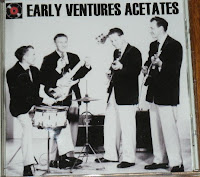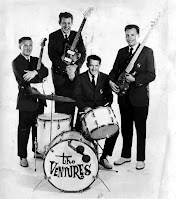 |
| Rick Turner Model 1 |
 |
| Rick Turner (recent photo) |
He also began playing in a band called Banana and the Bunch, with Lowell "Banana" Levinger and Michael Kane, who later played with The Youngbloods.
In 1964, the three musicians opened a music store in Martha's Vineyard. The next year Turner was invited to play guitar on tour with Ian & Sylvia. He also played on the duo's 1966 album, Play One More.
 |
| Early Days In A Band |
His band, Autosalvage, eventually split up and Turner moved to Point Reyes, California.
Then in 1970 Rick Turner, Ampex audio engineer, Ron Wickersham, Bob Matthews, a recording engineer, became three equal shareholders of Alembic Incorporated. Alembic was founded by Owsley Stanley in 1968, and was involved in the design and construction of the Alembic instruments.
The initial purpose of Stanley's company was formed to support and supply The Grateful Dead. After the sale Alembic went on to build exceptionally fine guitars and basses.
In 1979 Turner founded Rick Turner Guitars, the business he ran for the remainder of his life.
Turner joined Gibson in 1988 where he served as president of Gibson Labs West Coast R&D Division.
 |
| 1992 Gibson Chet Atkins SST |
 |
| Rick Turner |
Through Rick Turner Guitars he continued to design and build guitars for many professional players including Lindsey Buckingham, Ry Cooder, David Lindley, and Andy Summers. He was also a regular columnist for Acoustic Guitar magazine and was a columnist for Bass Player, Frets and Guitar Player magazines.
 |
| D-Tar Pickup-Mic System |
The Turner Model 1 pioneered the use of curved plates on the front and back in order to reduce standing wave hysteresis loss and the use of 18 volt preamps in an attempt to tame the 'quack' sound commonly associated with piezoelectric acoustic guitar pickups.
Rick Turner also held the patent on the graphite guitar neck, which he developed in 1976 with Geoff Gould. Gould used this neck as the basis for his guitar/bass replacement neck company; Modulus Graphite.
Rick Turner was generous with his time and taught mandolin-building courses in the US and Australia and was extremely active on a wide range of musical instrument Internet forums and social media groups.
Turner died from congestive heart failure and a stroke on April 17, 2022, at the age of 78.
“Rick Turner was a gifted guitar maker, an innovator, and a special soul,” wrote Smith. “At the beginning of my career, he selflessly helped my company through a review in Guitar Player magazine. His honesty and willingness to help another instrument maker left a lifelong, very positive impression on me. I send my very best to his family and friends.” Rick Turner guitars, basses, and ukuleles are exquisite instruments.
 |
| Turner Model 1 and Model 1 Featherweight |
The guitars include two versions of The Model 1; The Model 1 and the Model 1 Featherweight.. Both versions of this guitar comes in 3 models; Deluxe, Standard, and Special.
These instruments include the Timerline Piezo pickup with the built-in D-TAR 18 volt preamp.
Turner also offers four versions of his Renaissance model guitars.
In addition to the company's guitar line, Rick Turner Guitars also offers three models of bass guitars.
 |
| The Pretzel |
Rick Turner built a couple of very interesting guitars in the 1970's. One of them, known as The Pretzel.
This instrument was built without using hand tools, other that a Sear electric drill and a drill press.
It was housed in the New York City Museum of Art and Design, the later moved to the San Francisco Museum of Modern Art.
The other guitar is the Turner Model T. The design was based on the shape of vintage Kay Kraft guitars from the 1920's, and a Double Horseshoe magnetic pickup based on Rickenbacker guitars of the 1930's, In addition to the horseshoe pickup, the electronics include an "all controls bypass switch, which provides a direct load-free signal to the output jack.
Click on the links below the pictures for sources. Click on links in text for further information.
©UniqueGuitar Publications 2022 (text only)
















































